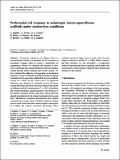| dc.contributor.author | Pandit, Abhay | |
| dc.contributor.author | Zeugolis, Dimitrios I. | |
| dc.date.accessioned | 2012-10-23T14:37:03Z | |
| dc.date.available | 2012-10-23T14:37:03Z | |
| dc.date.issued | 2010-11 | |
| dc.identifier.citation | English, A., Azeem, A., Gaspar, D.A., Keane, K., Kumar, P., Keeney, M., Rooney, N., Pandit, A. and Zeugolis, D.I. (2012) 'Preferential cell response to anisotropic electro-spun fibrous scaffolds under tension-free conditions'. Journal Of Materials Science: Materials In Medicine, 23 (1):137-148. | en_US |
| dc.identifier.uri | http://hdl.handle.net/10379/3000 | |
| dc.description | Journal article | en_US |
| dc.description.abstract | Anisotropic alignment of collagen fibres in musculoskeletal tissues is responsible for the resistance to mechanical loading, whilst in cornea is responsible for transparency. Herein, we evaluated the response of tenocytes, osteoblasts and corneal fibroblasts to the topographies created through electro-spinning and solvent casting. We also evaluated the influence of topography on mechanical properties. At day 14, human osteoblasts seeded on aligned orientated electro-spun mats exhibited the lowest metabolic activity (P < 0.001). At day 5 and at day 7, no significant difference was observed in metabolic activity of human corneal fibroblasts and bovine tenocytes respectively seeded on different scaffold conformations (P > 0.05). Osteoblasts and corneal fibroblasts aligned parallel to the direction of the aligned orientated electro-spun mats, whilst tenocytes aligned perpendicular to the aligned orientated electro-spun mats. Mechanical evaluation demonstrated that aligned orientated electro-spun fibres exhibited significant higher stress at break values than their random aligned counterparts (P < 0.006) and random orientated electro-spun fibres exhibited significant higher strain at break values than the aligned orientated scaffolds (P < 0.006). While maintaining fibre structure, we also developed a co-deposition method of spraying and electro-spinning, which enables the incorporation of microspheres within the three-dimensional structure of the scaffold. | en_US |
| dc.format | application/pdf | en_US |
| dc.language.iso | en | en_US |
| dc.publisher | Springer | en_US |
| dc.relation.ispartof | Journal Of Materials Science: Materials In Medicine | en |
| dc.rights | Attribution-NonCommercial-NoDerivs 3.0 Ireland | |
| dc.rights.uri | https://creativecommons.org/licenses/by-nc-nd/3.0/ie/ | |
| dc.subject | Anisotropic alignment | en_US |
| dc.subject | Collagen fibres | en_US |
| dc.subject | Musculoskeletal tissues | en_US |
| dc.title | Preferential cell response to anisotropic electro-spun fibrous scaffolds under tension-free conditions | en_US |
| dc.type | Article | en_US |
| dc.date.updated | 2012-10-18T16:16:30Z | |
| dc.description.peer-reviewed | peer-reviewed | |
| dc.internal.rssid | 1427030 | |
| dc.local.contact | Abhay Shashikant Pandit, Mechanical & Biomedical Eng, College Of Eng & Informatics, Room 304, Nfb Building, Ida Bus Park, Dangan, Nui Galway. 2758 Email: abhay.pandit@oegaillimh.ie | |
| dc.local.copyrightchecked | No | |
| dc.local.version | PUBLISHED | |
| nui.item.downloads | 696 | |


